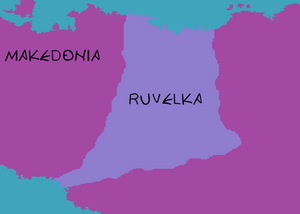Symmerian Ruvelka
In historiography, Makedonian Ruvelka refers to the period of Ruvelkan history where the country was under the control of the Makedonian Empire. Makedonian Ruvelka began in 238 BCE when Orestes II invaded the country and conquered the numerous tribes and mountain kingdoms of the Kurilla and Matra Mountain Ranges. Ruvelka was the first region outside modern Syara to be conquered by the Makedonians, and would be the last to be lost when the Arkoennites conquered the area in the late 13th Century. Unlike the Imperial Provinces of Mansuriyyah, Arkoenn, Serikos, and Quenmin, the borders of Ruvelka gradually changed over the course of the Empire due to shifting demographic and social change.
Like Mansuriyyah, ancient Ruvelka had been controlled by various nations and tribes, many of them located amid the foothills and mountains of the Kurilla and Matra Mountain Ranges, leading the Makedonians to label the Ruvelkan people bounósleṓs; literally mountain-people. At the time of conquest most of the native Ruvelkan population was restricted to the mountains, leaving much of the land west of the Kurillas to be settled by ethnic Syarans. Various other tribes inhabited western Ruvelka, several of which survived to modern day; this includes the Karvelebi, native to the the region of Zemplen, and the Imertan people. In the 5th Century CE the Hayren Migration launched by Alexarchus saw the mass settlement of ethnic Hayren within southern Syara and Ruvelka, where their descendants remain to this day.
Due to their early conquest and close proximity to Syara and Makedon itself, many Ruvelkans played major roles in the history of the Empire. Ruvelkan troops were the most recruited among Makedon's various satrapies and were especially prized for their heavy infantry. In battle, the Ancient Makedonian army almost always lined up Ruvelkan heavy infantry along the flanks of the Makedonian Phalangitès, pike phalanx. This became so common that a nickname for the Ruvelkans, Plagiophylax (flank guard) became common among Syarans. This has persisted into the modern era to a degree despite the lingusitic decline of the Makedonian language; the modern Syaran nickname for ethnic Ruvelkans, "крило" (krilo, flanker) is descended from this.
The onset of the Burning Plague had widespread repurcussions and began the Fall of the Makedonian Empire. In Ruvelka, the large loss of life triggered a demographic shift as ethnic Ruvelkans began settling the land between the Granika River and the Kurilla Mountains, eventually outnumbering ethnic Syarans and laying the groundwork for the shifting populations and borders between the two nations. During the early middle ages this saw the rise of various Ruvelkan duchies and principalities throughout what would become modern-day Ruvelka's borders. Many of these nations remained in existence even after the Arkoennite conquest and the formation of the Makedonian Khanate. The Ruvelkan duchies gradually grew more and more independent and dissociated from Makedonian rule, eventually culiminating in widespread rebellion that brought the dissolution of the Khanate and the establishment of the Rioni Union.
Numerous Makedonian ruins and monuments remain across Ruvelka, ranging from small monestaries to elaborate fortifications. Many of these surviving structures were later re-used by Ruvelkan kingdoms and states throughout history, and many remain popular tourist attractions.
